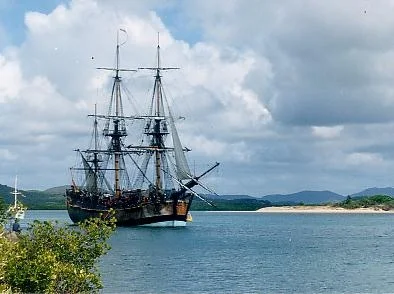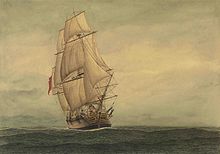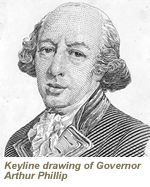The First Fleet brought the first white settlers to Australia.
There were 11 ships in the First Fleet.
The soldiers and convicts were led by Captain Arthur Phillip.
They arrived at Sydney Cove on January 26, 1788.
England in the 1770s
In the 1770s the discovery of steam power created new industries in the cities of England. People left country areas to find work in the new factories using steam power and cities became overcrowded, dirty, and with an increase in crime, unsafe. Harsh punishments were handed to criminals for their crimes and these included transportation. Transportation meant that convicts were sent to work for the rest of their lives in one of England's colonies.
The First Fleet carried the first white settlers to Australia
'Lady Penrhyn' one of the ships of the First Fleet
Before 1787 convicts from England had been sent to British colonies in North America. But, after the Americans fought the British in the Revolutionary War, drove them out and became the United States of America, the British need a new place to send their convicts. The First Fleet was the first group of ships to carry convicts to the British colony in Australia. Captain Arthur Phillip was in charge and his job was to establish a convict settlement in Australia.
First Fleet: timeline
13 May 1787 :
The ships sailed from Portsmouth, England. There were eleven small ships in the First Fleet: two naval ships, six convict ships and three store ships for supplies. Captain Arthur Phillip was in charge of the fleet.
Read about Arthur Phillip here.
Onboard were 1420 people: 722 convicts including 17 child convicts, the soldiers who were to guard them, soldiers' wives, sailors, and ship's officers.
Although most of the convicts were English, there were also African, American and French convicts.
Conditions were crowded and cramped for the convicts who were housed, for long periods of time, behind bars and often chained. For parts of the journey conditions below decks were hot and humid. Diseases such as dysentery and scurvy broke out.
About 48 people died during the voyage.
3 June 1787:
They arrived at Tenerife in the Canary Islands, stayed a week and took on supplies of fresh food and water.
The weather was hot and humid as the Fleet sailed through the tropics. Below the decks, rats and parasites such as bedbugs, lice, cockroaches and fleas made life very uncomfortable for everyone onboard.
5 July 1787:
They crossed the Equator
7 August 1787:
They arrived at Rio de Janeiro, stayed for a month repairing sails, collecting plants and seeds to be grown in New South Wales. The ships were cleaned and some of the convicts were given new clothes. The old clothes were burned to get rid of lice and fleas!
13 October 1787:
The fleet reached Table Bay (now Cape Town), Cape of Good Hope after surviving tremendous storms in the Atlantic Ocean. Stayed a month, and took on livestock (horses, sheep, goats).
25 December 1787:
The fleet was in the middle of the Indian Ocean.
1 January 1788:
They reached Adventure Bay, Van Diemen's Land (now Tasmania)
18 January 1788:
The fleet arrived at Botany Bay after sailing south of Van Diemen's Land, then north to New South Wales. It was decided that Botany Bay was not a suitable site for the settlement because water supply and soils were poor. The fleet sailed on.
The First Fleet entering Port Jackson (Wikipedia)
26 January 1788:
The members of the First Fleet went ashore at Port Jackson to start a settlement. Arthur Phillip named the place of landing Sydney Cove, after Lord Sydney, an official who had helped to organise the voyage.
The journey had lasted 252 days and sailed 24,000 kilometres. No ships were lost! Forty-eight people died on the journey.
Find a map of the journey taken by the First Fleet.
http://ltcfirstfleet.uow.edu.au/s_map.html





